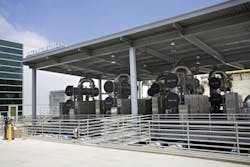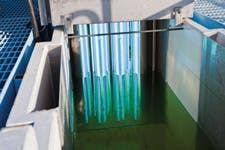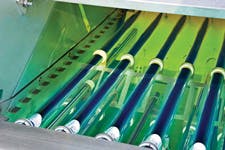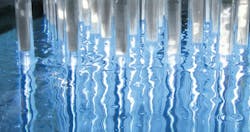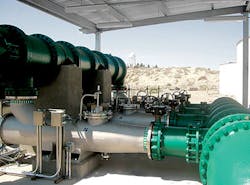How Are UV Technology Developments Keeping up with the Treatment of Micropollutants?
In the second part of the WWi series that compares technology offerings from manufacturers, we address the growing technology of Ultraviolet Treatment. We ask how manufacturers are keeping pace with micropollutants and emerging contaminants, which are making headlines globally.
UV-oxidation + RO systems treat harmful contaminants
Jennifer Muller, Vice president, global municipal sales, Trojan UV
Over the last century, UV light has played an increasingly key role in water disinfection. Disinfection without the addition of chemicals and their by-products, a small footprint and the ability to destroy chlorine-resistant microorganisms has contributed to its rapid adoption in recent years. It is also known that UV, either alone or in conjunction with an oxidant, can be used to treat chemical micropollutants, including but not limited to pesticides and pharmaceuticals which continue to be detected in water.
UV-oxidation is the combined action of UV light and an oxidant, such as hydrogen peroxide. The technology has emerged as a cost-effective option for treating difficult-to-remove contaminants, such as taste-and-odour compounds in drinking water or wastewater-derived contaminants in water reuse applications.
Here's how it works: First, UV light directly breaks down contaminants in a process called UV-photolysis. This process is the result of a micropollutant absorbing the high energy photons of UV light and subsequent breakdown of the contaminant. Some micropollutants, such as N-nitrosodimethylamine (NDMA), are preferentially treated through this mechanism. Other compounds that don't absorb UV light as readily can be degraded by a simultaneous process called UV-oxidation. The latter starts with the splitting of hydrogen peroxide into two hydroxyl radicals. These radicals react indiscriminately with micropollutants in water to destroy the target compound.
A large variety of micropollutants can be removed through the combination of these two processes. TrojanUV has performed extensive research to specifically evaluate how UV-oxidation systems treat harmful contaminants. For instance, agricultural run-off resulting from rainfall allows various pesticides and other chemicals used for crop maintenance to enter rivers and streams that provide source water to community water treatment plants.
Regulations globally place strict limits on the concentrations of contaminants – such as pesticides – that can enter the distribution system. UV-oxidation in water treatment systems is playing a key role in reducing the concentration of these harmful contaminants. The UV-oxidation process is also used for groundwater remediation, where harmful organic compounds such as tetrachloroethylene, 1,4-dioxane, and vinyl chloride are destroyed.
Today's changing climate is leading to water scarcity on a more widespread basis. Water stressed regions often use unconventional sources of drinking water in order to maintain a sustainable supply. For example, a number of communities globally treat wastewater to high levels of purity by removing the micropollutants that remain after secondary (biological wastewater) treatment. UV-oxidation, in combination with other treatment technologies such as reverse osmosis, works to remove micropollutants and generate water of the highest purity.
Company DevelopmentsTrojan's UV-oxidation equipment is now used at numerous water treatment systems worldwide. For example, in the Netherlands, tens of thousands of cubic liters of drinking water are treated every hour to remove pesticides. In the US, the Orange County Water District (California) is operating the world's largest advanced wastewater treatment plant that employs the TrojanUVPhox UV-oxidation system to remove NDMA and 1,4-dioxane following secondary wastewater treatment. The high purity effluent from this plant is re-injected into the local aquifer and reused for drinking water. Other drought-impacted States also employ TrojanUV for potable wastewater reuse systems similar to Orange County, including installations in Texas and New Mexico. Further, in Australia, the Eastern Treatment Plant located in Melbourne uses the TrojanUVFlex for advanced wastewater treatment with effluent being reused for agricultural purposes. |
Keeping O&M costs down
Stanley Shmia, UV product manager, Severn Trent Services
The use of ultraviolet light for drinking water disinfection has been in use in the United States for nearly a century. The use of UV disinfection increased rapidly in the 1980s and 1990s as municipalities looked for alternatives to chemical disinfectants, which had been shown to form carcinogenic by-products that are harmful to human health. Thousands of municipalities converted from chemical-based disinfection, such as chlorine gas, to UV due to the significant safety advantages.
Over time, however, owners of many UV systems expressed concerns about the overall expense of operating UV disinfection. Of specific concerns were the cost of lamp replacement, maintenance and the costs associated with keeping the system consistently operational. Conventional UV systems using electroded lamps fade over time, necessitating replacement every 12,000 operating hours, or about 15 months of continuous operation. In addition, as the UV lamps are cycled on and off, the wear and tear on the lamps is hastened. As lamps degrade or fail, operators must spend significant time making sure the UV systems are operating at peak performance, constantly motoring and replacing lamps.
Conventional systems also require wiper systems, often including chemicals, to keep the lamps sleeve clean and allow maximum UV light to penetrate into the water. These wiper systems add cost and complexity to the maintenance of the UV units themselves.
A key factor of UV water treatment is flow rate and precise water level control. If the flow is too high, water will pass through without enough UV exposure. If the flow is too low, heat may build up and damage the UV lamp. With the many benefits of UV disinfection, considerable research and development has been undertaken to develop new technologies that optimize the disinfection process while eliminating concerns about cost, system maintenance and reliability.
Company DevelopmentsEarlier this year STS launched the MicroDynamics Series OCS721, a new microwave-powered, open channel, ultraviolet system for municipal wastewater disinfection and water reuse applications. Modules can be placed side by side in channels to reduce civil works requirements. The technology uses microwaves to energize low-pressure, high-output, electrodeless lamps to generate a UVC output of 254 nm, an optimal wave length for bacterial disinfection. The MicroDynamics OCS721 system meets dose, log reduction and water quality requirements for a variety of applications. The system features MicroPace flow pace technology that matches UV dose to operating conditions in real time, resulting in additional energy savings. STS says the bulb replacement and maintenance costs of MicroDynamics systems can be as little as half of competing UV technologies, primarily driven by the electrodeless lamps. These lamps are designed to have very low residual radiation of energy and thus an almost instant shut-off capability. Eliminating the need for electrical connections in the water produces greater operational safety. |
UV technology developments are keeping abreast of both disinfection needs and the removal of micro-pollutants
Dr. Bertrand Dussert, Global UV business manager, Xylem Inc.
As analytical methods make us aware of newly discovered microorganisms and micropollutants, we need to ensure that our UV treatment technologies can successfully render these pathogens harmless - using a minimum amount of energy and requiring the lowest possible capital expenditure. Endocrine disrupting chemicals, pharmaceuticals and personal care products and waterborne pathogens such as Cryptosporidium and adenovirus are good examples of threats to our water supply which were discovered relatively recently.
As readers may be aware, Cryptosporidium is extremely resistant to chlorine and exhibits a strong resistance to other chemical disinfectants (ozone, chlorine dioxide), but is very readily inactivated by UV disinfection. In this way, the current challenge for the industry is to make this powerful and versatile technology more widely accessible by lowering operating and set up costs.
The challenge for the water industry and water technology companies specifically, is how to make these effective and powerful UV solutions as cost and energy efficient as possible. Within the area of UV oxidation technologies there is a move from medium pressure to low pressure UV systems which have a smaller carbon footprint as a result of incorporating more energy efficient UV lamps. More of this is exactly what we need. By making UV technologies more cost and energy efficient we can harness this powerful, environmentally sustainable tool to tackle newly discovered micro-organisms or micro-pollutants within our water supply.
Cost and energy efficient UV technologies will enable us to further develop water reuse capabilities globally and tackle the challenge of water scarcity.
Company DevelopmentsXylem's WEDECO Duron is a new, open channel UV disinfection system that delivers clean, safe treated wastewater using a minimum of energy. Designed for mid- and large-size wastewater treatment plants, the system is disinfection solution that eliminates the need for chemical-based disinfection. Using a low amount of mercury, WEDECO ECORAY UV lamps have a power of 600W and are arranged in a 45° vertical inclined geometry. This design is in place to optimize the hydraulics and performance efficiency. Furthermore, fewer lamps are needed thanks to enhanced ballast technology and thirdly a proven intelligent dose control minimizes the energy consumption at all operating conditions. UV lamps can be replaced without removing the modules from the water. If, occasionally modules need to be taken out of the channel this is done via an integrated compact, automatic lifting mechanism. |
Preventing the use of antibiotics in water
Volker Adam, UV expert for water treatment, Heraeus Noblelight GmbH
A large number of applications such as drinking-water purification, process water in beverage and food production, fish farming and agricultural irrigation systems have the additional requirement that residue of drugs, hormones, pesticides and herbicides need to be decomposed.
For example, in fish farming, antibiotics are added to the water to reduce the growth and spread of pathogenic germs. The antibiotics are a threat to people when they eat fish. The purification of water with UV light often makes the use of antibiotics unnecessary. A resistance to antibiotics in the human body, which has a negative effect on health, is therefore prevented.
Advanced oxidation additionally uses the UV radiation in the range below 250 nanometres. The light with even higher energy destroys substances in the water which are difficult or impossible to decompose, and breaks up and inactivates chemical compounds. The process is used for example against the "chlorine smell" - so called chloramines, in public swimming pools. Chloramin formation happens in water when chlorine reacts with urea, creatinine and amino acids. Short-wave UV light can decompose these compounds.
Company DevelopmentsThe manufacturing process for the Heraeus UV lamps prevents the transmission loss of the quartz glass. The result is an almost constant disinfection effect over the entire service life of the lamp. Up to 90% of the UVC output power is achieved even after up to 16,000 hours of operation. In addition to this, the Longlife amalgam lamps achieve a UV power density of up to ten times more when compared to conventional mercury low-pressure lamps and can be used at higher ambient temperatures of up to 90°C. Moreover, amalgam lamps are less sensitive to temperature fluctuation. |
Advance modelling tools
Tony Leigh, Technical sales director, atg UV Technology
Utilising UV disinfection to eliminate waterborne pathogens is increasing in popularity due to the increasing efficiency of the UV treatment systems and the increasing ability to match the treatment levels to the process requirement.
Advance modelling tools are allowing the designs of UV systems with more and more efficient application of UV energy. Third party testing and validation standards such as the US EPA and NWRI allow the performance of the equipment to be much better understood, tested and matched to the design tools giving users more confidence in the ability of the equipment to meet process disinfection requirements.
Research on the sensitivity to UV of new organisms can be conducted in the laboratory using collimated beam experiments and can be easily related to third party validated performance tests. Modelling tools allow system designs to be developed to treat up to increasingly high log reductions and also to treat more difficult to kill organisms providing much greater range and flexibility of treatment. New regulatory language is under development in many markets sectors and industries that will allow users and designers to specify UV equipment with more confidence by specifying validated performance requirements. New products have been developed to allow disinfection of organisms in very low transmission fluids such as liquid sugar, brines and milk, opening up more new processes to UV technology. More powerful lamps housed in much larger treatment systems are also improving the efficiency of treatment and reducing the size of civil structures required. These new advances have created products that can now be used for 'toilet to tap' projects, helping to conserve water in stressed areas across the USA.
Company Developmentsatg UV's new line of NWRI Validated (Drinking Water & Water Re-use) 800 Watt UV reactors have been developed using the latest in amalgam lamp technology. The 800 Watt amalgam lamp technology will be incorporated into closed vessel 316L Stainless Steel UV reactors and will be targeted for use in a wide range of applications including drinking water, wastewater, reuse/recycled water and industrial process water. |


